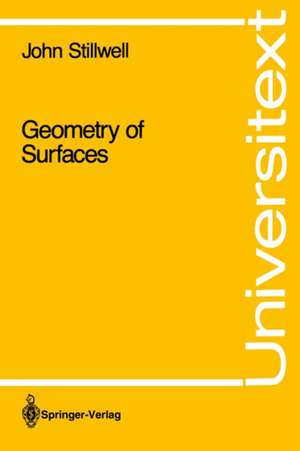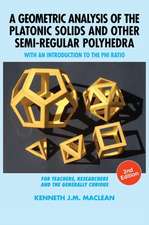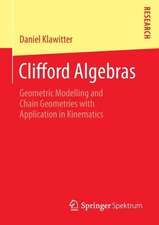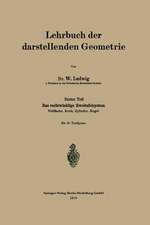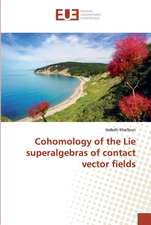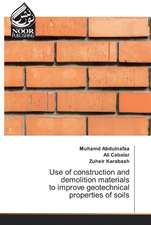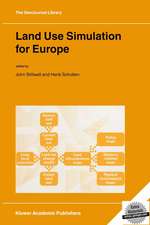Geometry of Surfaces: Universitext
Autor John Stillwellen Limba Engleză Paperback – 24 iun 1992
Din seria Universitext
- 13%
 Preț: 353.48 lei
Preț: 353.48 lei -
 Preț: 418.67 lei
Preț: 418.67 lei -
 Preț: 465.61 lei
Preț: 465.61 lei -
 Preț: 358.44 lei
Preț: 358.44 lei - 17%
 Preț: 394.41 lei
Preț: 394.41 lei - 15%
 Preț: 737.46 lei
Preț: 737.46 lei - 17%
 Preț: 364.56 lei
Preț: 364.56 lei - 15%
 Preț: 543.75 lei
Preț: 543.75 lei - 15%
 Preț: 497.21 lei
Preț: 497.21 lei -
 Preț: 634.38 lei
Preț: 634.38 lei -
 Preț: 360.93 lei
Preț: 360.93 lei - 17%
 Preț: 431.50 lei
Preț: 431.50 lei - 13%
 Preț: 355.51 lei
Preț: 355.51 lei - 17%
 Preț: 364.81 lei
Preț: 364.81 lei -
 Preț: 396.53 lei
Preț: 396.53 lei - 17%
 Preț: 365.34 lei
Preț: 365.34 lei - 15%
 Preț: 553.33 lei
Preț: 553.33 lei -
 Preț: 371.98 lei
Preț: 371.98 lei -
 Preț: 673.45 lei
Preț: 673.45 lei - 15%
 Preț: 509.58 lei
Preț: 509.58 lei - 17%
 Preț: 427.32 lei
Preț: 427.32 lei - 17%
 Preț: 426.76 lei
Preț: 426.76 lei - 17%
 Preț: 427.68 lei
Preț: 427.68 lei - 20%
 Preț: 569.54 lei
Preț: 569.54 lei -
 Preț: 356.77 lei
Preț: 356.77 lei - 17%
 Preț: 369.06 lei
Preț: 369.06 lei - 19%
 Preț: 429.21 lei
Preț: 429.21 lei -
 Preț: 487.96 lei
Preț: 487.96 lei - 20%
 Preț: 628.22 lei
Preț: 628.22 lei -
 Preț: 372.86 lei
Preț: 372.86 lei -
 Preț: 319.07 lei
Preț: 319.07 lei -
 Preț: 379.86 lei
Preț: 379.86 lei -
 Preț: 445.88 lei
Preț: 445.88 lei -
 Preț: 382.36 lei
Preț: 382.36 lei - 15%
 Preț: 533.72 lei
Preț: 533.72 lei - 15%
 Preț: 496.02 lei
Preț: 496.02 lei - 15%
 Preț: 474.82 lei
Preț: 474.82 lei -
 Preț: 389.70 lei
Preț: 389.70 lei -
 Preț: 484.08 lei
Preț: 484.08 lei - 15%
 Preț: 469.48 lei
Preț: 469.48 lei - 15%
 Preț: 643.48 lei
Preț: 643.48 lei -
 Preț: 415.02 lei
Preț: 415.02 lei - 15%
 Preț: 602.25 lei
Preț: 602.25 lei - 20%
 Preț: 510.24 lei
Preț: 510.24 lei - 15%
 Preț: 588.37 lei
Preț: 588.37 lei -
 Preț: 381.59 lei
Preț: 381.59 lei -
 Preț: 489.87 lei
Preț: 489.87 lei -
 Preț: 493.89 lei
Preț: 493.89 lei - 20%
 Preț: 332.24 lei
Preț: 332.24 lei
Preț: 450.88 lei
Nou
Puncte Express: 676
Preț estimativ în valută:
86.29€ • 89.02$ • 73.03£
86.29€ • 89.02$ • 73.03£
Carte tipărită la comandă
Livrare economică 05-19 martie
Preluare comenzi: 021 569.72.76
Specificații
ISBN-13: 9780387977430
ISBN-10: 0387977430
Pagini: 236
Ilustrații: XI, 236 p.
Dimensiuni: 155 x 235 x 13 mm
Greutate: 0.33 kg
Ediția:1992
Editura: Springer
Colecția Springer
Seria Universitext
Locul publicării:New York, NY, United States
ISBN-10: 0387977430
Pagini: 236
Ilustrații: XI, 236 p.
Dimensiuni: 155 x 235 x 13 mm
Greutate: 0.33 kg
Ediția:1992
Editura: Springer
Colecția Springer
Seria Universitext
Locul publicării:New York, NY, United States
Public țintă
Lower undergraduateCuprins
1. The Euclidean Plane.- 1.1 Approaches to Euclidean Geometry.- 1.2 Isometries.- 1.3 Rotations and Reflections.- 1.4 The Three Reflections Theorem.- 1.5 Orientation-Reversing Isometries.- 1.6 Distinctive Features of Euclidean Geometry.- 1.7 Discussion.- 2. Euclidean Surfaces.- 2.1 Euclid on Manifolds.- 2.2 The Cylinder.- 2.3 The Twisted Cylinder.- 2.4 The Torus and the Klein Bottle.- 2.5 Quotient Surfaces.- 2.6 A Nondiscontinuous Group.- 2.7 Euclidean Surfaces.- 2.8 Covering a Surface by the Plane.- 2.9 The Covering Isometry Group.- 2.10 Discussion.- 3. The Sphere.- 3.1 The Sphere S2 in ?3.- 3.2 Rotations.- 3.3 Stereographic Projection.- 3.4 Inversion and the Complex Coordinate on the Sphere.- 3.5 Reflections and Rotations as Complex Functions.- 3.6 The Antipodal Map and the Elliptic Plane.- 3.7 Remarks on Groups, Spheres and Projective Spaces.- 3.8 The Area of a Triangle.- 3.9 The Regular Polyhedra.- 3.10 Discussion.- 4. The Hyperbolic Plane.- 4.1 Negative Curvature and the Half-Plane.- 4.2 The Half-Plane Model and the Conformai Disc Model.- 4.3 The Three Reflections Theorem.- 4.4 Isometries as Complex Functions.- 4.5 Geometric Description of Isometries.- 4.6 Classification of Isometries.- 4.7 The Area of a Triangle.- 4.8 The Projective Disc Model.- 4.9 Hyperbolic Space.- 4.10 Discussion.- 5. Hyperbolic Surfaces.- 5.1 Hyperbolic Surfaces and the Killing-Hopf Theorem.- 5.2 The Pseudosphere.- 5.3 The Punctured Sphere.- 5.4 Dense Lines on the Punctured Sphere.- 5.5 General Construction of Hyperbolic Surfaces from Polygons.- 5.6 Geometric Realization of Compact Surfaces.- 5.7 Completeness of Compact Geometric Surfaces.- 5.8 Compact Hyperbolic Surfaces.- 5.9 Discussion.- 6. Paths and Geodesies.- 6.1 Topological Classification of Surfaces.- 6.2 Geometric Classification ofSurfaces.- 6.3 Paths and Homotopy.- 6.4 Lifting Paths and Lifting Homotopies.- 6.5 The Fundamental Group.- 6.6 Generators and Relations for the Fundamental Group.- 6.7 Fundamental Group and Genus.- 6.8 Closed Geodesic Paths.- 6.9 Classification of Closed Geodesic Paths.- 6.10 Discussion.- 7. Planar and Spherical Tessellations.- 7.1 Symmetric Tessellations.- 7.2 Conditions for a Polygon to Be a Fundamental Region.- 7.3 The Triangle Tessellations.- 7.4 Poincaré’s Theorem for Compact Polygons.- 7.5 Discussion.- 8. Tessellations of Compact Surfaces.- 8.1 Orbifolds and Desingularizations.- 8.2 Prom Desingularization to Symmetric Tessellation.- 8.3 Desingularizations as (Branched) Coverings.- 8.4 Some Methods of Desingularization.- 8.5 Reduction to a Permutation Problem.- 8.6 Solution of the Permutation Problem.- 8.7 Discussion.- References.
